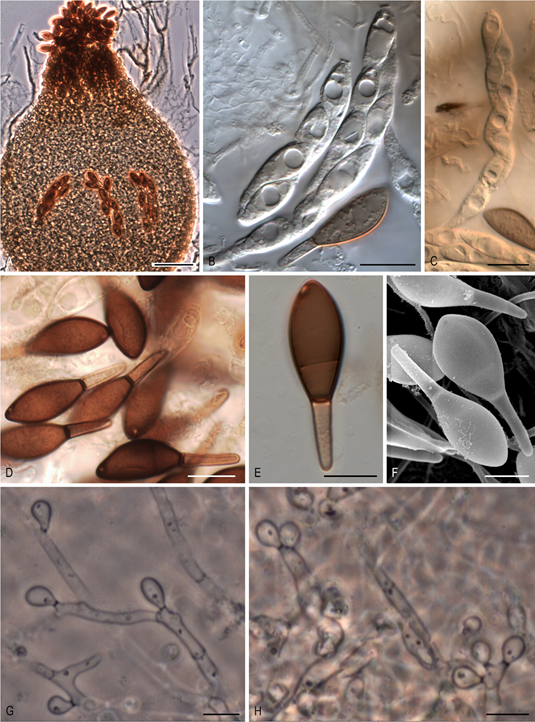Naviculispora terrestris Stchigel, Y. Marín, Cano & Guarro, in Marin-Felix, Miller, Cano-Lira, Guarro, García, Stadler, Huhndorf & Stchigel, Microorganisms 8(9, no. 1430): 15 (2020)
Index Fungorum number: IF 812136; MycoBank number: MB 812136; Facesoffungi number: FoF 14641.
Etymology – Referring to the substrate from which the fungus has been isolated.
Type material – ARGENTINA: Tucumán province, Tafí del Valle, -26.8667, -65.6833, from soil, 17-V-2000, A. M. Stchigel, J. Cano, J. Guarro. (holotype CBS H-2159; ex-type cultures CBS 137295 = FMR 10060).
Mycelium composed of subhyaline to brown, septate, smooth-walled, branched hyphae, 1.5–4 µm wide. Sexual morph Ascomata ostiolate, superficial or immersed, scattered to aggregated, pale brown to brown, pyriform, 210–410 × 160–380 µm, covered with brown, septate hyphae-like hairs, occasionally with 2 necks; necks short, brown to dark brown, cylindrical to conical, papillate, 35–70 µm long, 62.5–105 µm wide. Ascomatal wall membranaceous, 10–20 µm thick, composed of up to 10 layers of flattened cells of 2–10 µm in diam, textura angularis. Asci unitunicate, 8-spored, cylindrical, evanescent, 100–150 × 15–20 µm, short stipitate, with small apical ring. Ascospores uniseriate to biseriate, at first one-celled, hyaline, clavate, becoming transversely septate and two-celled; upper cell dark brown, navicular, 20–29 × 9–13.5 µm, truncate at the base, septate, with a subapical to apical germ pore of 0.5–1 µm; lower cell pale brown, cylindrical-conical, thick-walled, 10–14(–17) × (2–)3–4 µm, not collapsing; gelatinous cauda absent. Asexual morph present. Conidia holoblastic, 3–8 × 2–3 µm, hyaline to subhyaline, ellipsoidal to ovoid or clavate, with a small truncate base, sessile, produced laterally and terminally on the hyphae, or less commonly on sympodially proliferating conidiophores.
Culture characteristics – Colonies on PCA attaining a diam. of 40–47 mm in 14 d at 25 ◦C, velvety, slightly lobulate, margins fringed, radially zonate, greyish-brown (M 5D3 to 5E3) and brown to dark brown (6E3 to 6F3) at center; reverse greyish-yellow to olive brown (4B4 to 4D4). Colonies on OA attaining a diam. of 35–38 mm in 14 d at 25 ◦C, velvety, margins regular to slightly arachnoid, grey to greyish-brown (M 8F1 to 8F3); reverse grey to greyish brown (M 8F1 to 8F3). Ascomata produced after at least two months. Maximum and minimum temperatures of growth, 5 and 30 ◦C, respectively. Optimal temperature 25 ◦C.

Figure 4. Naviculispora terrestris CBS 137295T. (A) Ascomata. (B,C) Asci. (D–F) Ascospores. (G) Conidia sessile. (H) Conidia borne on sympodially proliferating conidiophores. Scale bars: (A) = 100 µm; (B,C) = 20 µm; (D) = 15 µm; (E,F) = 10 µm; (G,H) = 5 µm.
